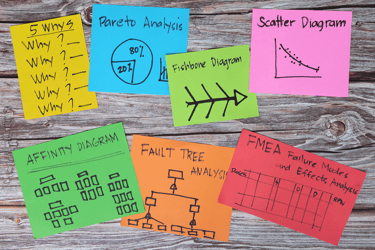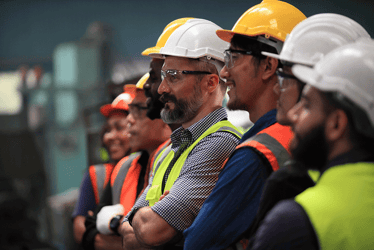The Packaging Industry's Sustainability Challenge: Why ERP Systems Are Essential for Success A straightforward guide to navigating sustainability regulations across folding carton, flexible...
Sustainability at the forefront: insights from the “Engage” event
Last week, I had the privilege of attending the Sustainable Packaging Coalition’s (SPC) "Engage" event in Chicago, IL.
As an advocate for sustainable practices in packaging, it was an inspiring experience to be surrounded by industry leaders, all dedicated to reducing the environmental footprint of packaging. The event brought together packaging suppliers, brands, and technology innovators, focused on the collective mission of improving sustainability through collaboration and technological advancements.
The SPC, plays a crucial role in educating companies on the importance of a circular economy. Their events focus on the entire lifecycle of packaging materials, pushing the industry towards environmentally responsible solutions. Engage 2024 continued this tradition, with a sharp focus on technologies to drive change.
What was clear at the conference was the need to quantify the impact design and manufacturing decisions had on Packaging.
These decisions now have a financial impact, through the Extended Producer Responsibility (EPR) policy. It is an approach that holds manufacturers accountable for the entire lifecycle of their products, including the post-consumer stage. In the context of packaging, EPR mandates that companies are responsible for the collection, recycling, and disposal of packaging materials after their use. This framework incentivizes producers to design packaging that is easier to recycle and reduces environmental impact. By enforcing compliance through regulatory requirements, EPR aims to promote more sustainable packaging solutions, encourage circular economy practices.
This is where technology has stepped in, providing tools that help companies manage their compliance obligations while driving sustainable practices across the value chain. Here are some key technologies presented at the event that are poised to make a substantial impact:
Contents
- Major technologies driving sustainability and EPR reporting
- Carbon Quota, Esko & eProductivity: Data-driven sustainability
- Collaboration is key to sustainable success
- Call to action
Major technologies driving sustainability and EPR reporting
Aura and e-halo for EPR compliance
Gillian Garside-Wight from Aura Consultants introduced their latest innovation, e-halo, a software specifically designed to simplify EPR compliance reporting for the packaging industry. The tool is engineered to handle the full spectrum of packaging materials—primary, secondary, and tertiary.
“It’s evident that the packaging industry is evolving, and stakeholders are increasingly aware of the need to address sustainability and regulatory compliance.” Gillian Garside-Wight
What sets e-halo apart is its ability to develop detailed engineering specifications for each type of packaging, ensuring that brands have an accurate picture of their packaging's material composition.
With EPR mandates becoming stricter across the globe, e-halo enables brands to navigate the complexity of different packaging materials and their impact on recyclability. The platform also incorporates built-in collaboration features, allowing stakeholders from different areas of the supply chain to work together seamlessly. This integration of data-sharing capabilities is crucial as companies strive to meet their EPR obligations while enhancing sustainability.
Carbon Quota, Esko & eProductivity: Data-driven sustainability
One of the event's highlights from me was a fireside chat with Dominic Harris from CarbonQuota, Geert De Proost from Esko, and myself. We discussed how technology is being leveraged to reduce the carbon footprint of packaging. CarbonQuota’s approach to automating carbon footprint calculations represents a major leap forward for the packaging industry.
Traditionally, calculating a product's carbon impact was a labor-intensive process, but through partnerships with companies like Esko and eProductivity Software, this process has been streamlined.
“Begin with the end in mind” - Dr. Stephen R. Covey
Esko’s platform plays a significant role in the design phase of packaging, enabling companies to minimize material usage and reduce waste through better planning and palletization techniques. As Geert pointed out, “Design is the biggest lever we have to drive sustainability.” By incorporating sustainability metrics directly into the design process, companies can make better-informed decisions at the onset, reducing environmental impacts before packaging even reaches production.
In our discussion, I realized how important EPR reporting and carbon footprinting, can provide data to drive sustainability in real-time. The combination of CarbonQuota’s certified carbon score capabilities with Esko’s design tools means that converters can now not only estimate the costs of their packaging but also its environmental impact. This is a game-changer for brands looking to align their business goals with sustainability targets. Our partnership ensures that businesses can make data-driven decisions that benefit both the environment and the bottom line.
Collaboration is key to sustainable success
“27 % of packaging professionals are unsure about whether their company is on the right track to meeting its sustainability targets. This marks a 5 % increase from the previous year, indicating a growing uncertainty in the packaging industry.” - Pack-Lab SPC Impact 2024 Survey
As noted during the event, solving the sustainability challenges facing the packaging industry is not a task any one company or sector can tackle alone. The collaboration between technology providers, brands, and packaging suppliers is what will ultimately drive meaningful change. Technologies such as e-halo, ePS traceability software, and the combination of CarbonQuota and Esko’s tools, underscore the importance of using data and automation to achieve sustainability goals.
These tools not only streamline EPR reporting but also empower companies to take proactive steps towards reducing their environmental footprint. By integrating sustainability into every stage of the packaging lifecycle—from design to disposal—the industry can move closer to achieving a circular economy. One critical element in this process is the use of traceability technology. The ability to monitor packaging materials in real time provides companies with accurate, unfaltering data about each step of the product’s life cycle. This level of precision is essential for ensuring that EPR reporting reflects the true environmental impact of packaging, allowing businesses to stay compliant and make informed, responsible choices.
Call to action
“Fear isn’t effective for long-term action. When we can show people the promised land, make success inevitable, people will want to join a winning team” - From Molly Kawahata's presentation on climate action at SPC Impact back in April.
For brands and packaging companies looking to take the next step in their sustainability journey, it’s time to embrace these innovative tools. One crucial aspect of this transformation is the importance of traceability in packaging production. By having infallible real-time data, companies can accurately track materials from production through to recycling, ensuring that the final EPR reporting is both precise and compliant with regulatory demands.
Accurate data not only improves transparency but also helps businesses identify areas for improvement in their sustainability efforts. Real-time insights into the lifecycle of packaging materials allow brands to make informed decisions on design, materials, and processes, which directly affect their environmental impact. Traceability also empowers companies to meet evolving regulatory requirements more effectively, ensuring they stay ahead in a fast-changing landscape.
By leveraging these tools and collaborating with leaders in the field, we can all contribute to reducing our environmental impact.
Let’s make sustainability more than just a goal... Let’s make it a reality.




